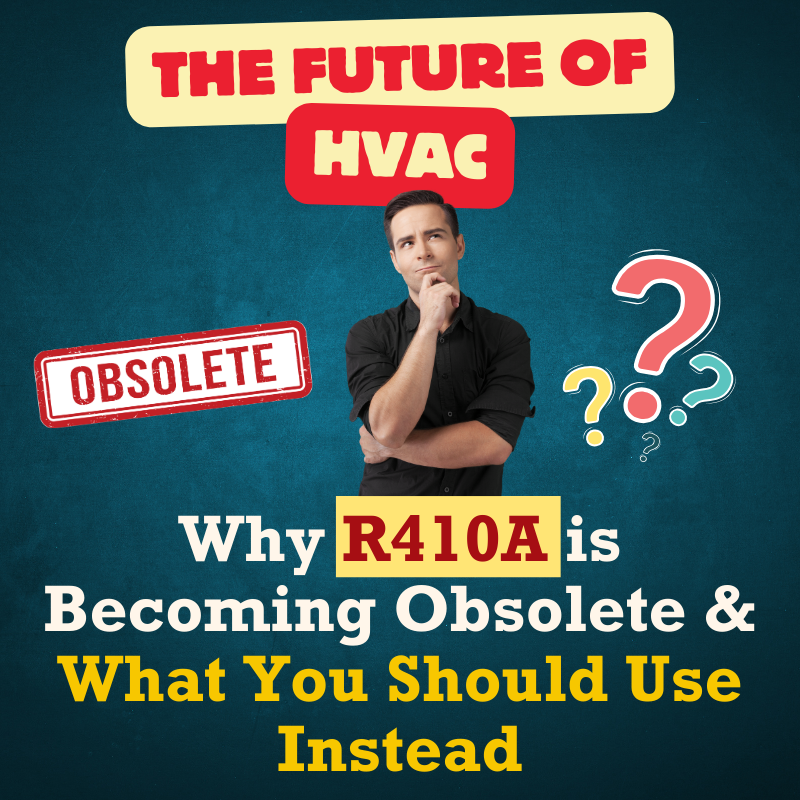As the world pushes towards more sustainable and energy-efficient solutions, the HVAC industry is undergoing a significant transformation. One of the most notable changes is the gradual phasing out of R410A refrigerant, which has long been a standard in air conditioning and heat pump systems. But why is R410A becoming obsolete, and what should you use instead? This blog explores the reasons behind this shift and highlights the alternatives that are shaping the future of HVAC.
Why R410A is Being Phased Out
-
High Global Warming Potential (GWP):
The primary reason for the decline of R410A is its high Global Warming Potential (GWP). GWP is a measure of how much heat a greenhouse gas traps in the atmosphere over a specific period, relative to carbon dioxide (CO2). R410A has a GWP of 2,088, meaning it is more than 2,000 times more potent than CO2 in terms of contributing to global warming. As global efforts to combat climate change intensify, refrigerants with high GWP are being phased out in favor of more environmentally friendly options. -
Stricter Environmental Regulations:
Environmental regulations are increasingly targeting refrigerants like R410A due to their impact on global warming. The Kigali Amendment to the Montreal Protocol, for example, mandates a global phase-down of hydrofluorocarbons (HFCs) like R410A. Countries around the world, including the United States, are implementing stricter regulations and guidelines that limit or ban the use of high-GWP refrigerants. As a result, R410A is becoming less viable for long-term use in HVAC systems. R32 HVAC systems are compliant are becoming the standard in the industry. -
Availability and Cost Issues:
As the phase-out of R410A progresses, the availability of this refrigerant is expected to decrease, leading to higher costs for both the refrigerant itself and the maintenance of systems that rely on it. HVAC manufacturers and service providers are already preparing for this shift by transitioning to alternative refrigerants, making R410A systems less common and more expensive to maintain over time.

Discover Top-Grade Air Conditioners: View Our Products Today
What Should You Use Instead?
-
R32 Refrigerant: The Leading Alternative
R32 has emerged as the leading alternative to R410A, thanks to its lower GWP and superior efficiency. With a GWP of 675—significantly lower than R410A—R32 is a more environmentally friendly option that reduces the carbon footprint of HVAC systems. Additionally, R32 offers better thermodynamic properties, allowing for more efficient heat transfer, which can lead to lower energy consumption and reduced operating costs.
Benefits of R32:
- Lower GWP: Reduces environmental impact and aligns with global sustainability goals.
- Improved Energy Efficiency: Enhanced performance and lower energy bills.
- Compatibility with Modern HVAC Technologies: Designed for use with the latest HVAC systems, ensuring long-term reliability and compliance with future regulations.
- Other Low-GWP Alternatives:
- R454B: With a GWP of 466, R454B is another promising alternative that offers a significant reduction in environmental impact compared to R410A. It is being adopted in some markets as a replacement for R410A, particularly in commercial HVAC applications.
- R466A: Known as a non-flammable alternative to R410A, R466A has a GWP of 733 and is gaining traction as a safe and environmentally responsible refrigerant for various HVAC applications.
-
CO2 (R744) Refrigerant:
For certain specialized applications, CO2 (R744) is being explored as a natural refrigerant with a GWP of 1, making it one of the most environmentally friendly options available. While CO2 systems require specific design considerations due to high operating pressures, they are an excellent choice for applications where sustainability is a top priority.
The Future of HVAC with R32 and Other Alternatives
-
Regulatory Compliance:
As regulations continue to tighten, adopting low-GWP refrigerants like R32 will be essential for ensuring compliance. By transitioning to these alternatives now, homeowners and businesses can avoid future disruptions and additional costs associated with retrofitting or replacing non-compliant systems. -
Enhanced System Performance:
Refrigerants like R32 not only reduce environmental impact but also improve the overall performance of HVAC systems. Better heat transfer, lower operating pressures, and compatibility with modern technologies make these refrigerants ideal for high-efficiency systems that deliver consistent comfort and reliability. -
Long-Term Cost Savings:
While the initial transition to a new refrigerant may involve some upfront costs, the long-term savings in terms of energy efficiency, reduced maintenance, and compliance with regulations make it a financially sound decision. As R410A becomes more expensive and less available, the cost benefits of switching to a refrigerant like R32 will become increasingly apparent.
Conclusion: Embracing the Future of HVAC
The obsolescence of R410A marks a pivotal moment in the evolution of HVAC technology. As the industry moves towards more sustainable solutions, refrigerants like R32 are leading the way, offering a powerful combination of environmental benefits, improved efficiency, and regulatory compliance. For anyone considering a new HVAC system or looking to upgrade an existing one, transitioning to R32 or other low-GWP refrigerants is a smart move that future-proofs your investment while contributing to global sustainability efforts.
By embracing these changes, you can ensure that your HVAC system is not only ready for the future but also plays a part in protecting the planet for generations to come.







